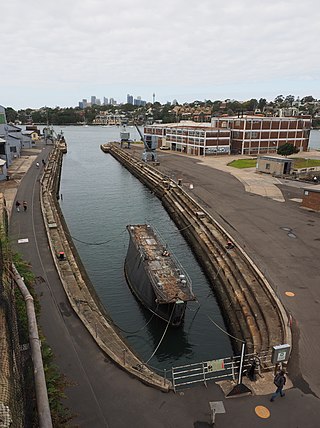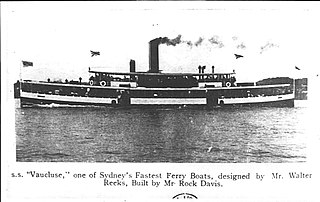Related Research Articles

Garden Island is an inner-city locality of Sydney, Australia, and the location of a major Royal Australian Navy (RAN) base. It is located to the north-east of the Sydney central business district and juts out into Port Jackson, immediately to the north of the suburb of Potts Point. Used for government and naval purposes since the earliest days of the colony of Sydney, it was originally a completely-detached island but was joined to the Potts Point shoreline by major land reclamation work during World War II.

HMAS Kuttabul, formerly SS Kuttabul, was a Royal Australian Navy depot ship, converted from a Sydney Ferries Limited ferry.

HMAS Kuttabul is a Royal Australian Navy (RAN) base located in Potts Point in Sydney, New South Wales, Australia. Kuttabul provides administrative, training, logistics and accommodation support to naval personnel assigned to the various facilities that form Fleet Base East, the main operational navy base on the east coast of Australia. A part of Fleet Base East itself, Kuttabul occupies several buildings in the Sydney suburb of Potts Point and in the immediately adjacent Garden Island dockyard. It also supports navy personnel posted to other locations throughout the greater Sydney region.

The Hawkesbury River railway bridge is a heritage-listed railway bridge in New South Wales, Australia that carries the Main North railway line across the Hawkesbury River. The bridge crosses between Brooklyn on the northern outskirts of Sydney and Cogra Bay in the Central Coast region. The railway bridge was to be the last link in a railway network that linked the state capitals Adelaide, Melbourne, Sydney and Brisbane and was a major engineering feat at the time. The original railway bridge was built in 1889 and replaced by the current bridge in 1946. The 1946 bridge was added to the New South Wales State Heritage Register on 2 April 1999.

The Newcastle Tram System was an extensive network that operated between Newcastle and the outer suburb of Wallsend from 1887 to 1950. At its peak the line extended from the city to Speers Point and West Wallsend. The service was rarely profitable, and low utilisation for a variety of reasons including the convenience of buses led to it closing and the tracks being removed.

The State Dockyard was a ship building and maintenance facility operated by the Government of New South Wales in Carrington, Newcastle, New South Wales, Australia between 1942 and 1987.

Mort's Dock is a former dry dock, slipway, and shipyard in Balmain, New South Wales, Australia. It was the first dry dock in Australia, opening for business in 1855 and closing more than a century later in 1959. The site is now parkland.

Fitzroy Dock is a heritage-listed dockyard at the former Cockatoo Island Dockyard, Cockatoo Island, Sydney Harbour, New South Wales, Australia. It was added to the Australian Commonwealth Heritage List on 22 June 2004.

The Woy Woy railway tunnel is a heritage-listed railway tunnel located between Wondabyne and Woy Woy stations on the Main Northern railway line in New South Wales, Australia. The dual-track 1.69-kilometre tunnel was opened on 16 January 1888. It was added to the New South Wales State Heritage Register on 28 June 2013.

Koompartoo was a 1922 Sydney Ferries Limited K-class ferry later converted to a Royal Australian Navy boom defence vessel. Koompartoo, described in the press as a "Dreadnought for the Milsons Point run" and "a titan amongst ferries", was along with her sister ferry, Kuttabul, the highest capacity ferries ever on Sydney Harbour.

Kuramia was a "K-class" ferry on Sydney Harbour. Commissioned in 1914, the timber-hulled steamer was built for Sydney Ferries Limited during the early twentieth boom in cross-harbour ferry travel. At 353 tons, she was the largest wooden ferry on Sydney Harbour.

The New South Wales Standard suburban carriage stock are a class of electric multiple units that were operated by the New South Wales Government Railways and its successors between 1926 and 1992. They served on the Sydney suburban network. In the years before their withdrawal, they were nicknamed Red Rattlers.

SS Kooroongaba was a vehicle ferry built for Sydney Ferries Limited. It later operated in Newcastle.
The coastal coal-carrying trade of New South Wales involved the shipping of coal—mainly for local consumption but also for export or coal bunkering—by sea to Sydney from the northern and southern coal fields of New South Wales. It took place in the 19th and 20th centuries. It should not be confused with the export coal trade, which still exists today. There was also an interstate trade, carrying coal and coke to other Australian states that did not have local sources of black coal.

The Garden Island Naval Precinct is a heritage-listed naval base and defence precinct located at Cowper Wharf Roadway in the inner eastern Sydney neighbourhood of Garden Island, New South Wales, Australia. The precinct was built from 1856. It includes the HMAS Kuttabul naval base, formerly known as HMAS Penguin. The property is owned by Australian Department of Defence. It was added to the Commonwealth Heritage List on 22 June 2004 and the New South Wales State Heritage Register on 12 November 2004.

SS Kuring-gai was a ferry that served on the Sydney to Manly run from 1901 to 1928.

Vaucluse was a ferry on Sydney Harbour that served on the Circular Quay to Watsons Bay run. She was launched in 1905, and was one of the fastest ferries in Sydney. She was sent to Newcastle after which her fate is unknown. She was named after the Sydney suburb, Vaucluse.

Sydney Harbour ferry services date back to the first years of Sydney's European settlement. Slow and sporadic boats ran along the Parramatta River from Sydney to Parramatta and served the agricultural settlements in between. By the mid-1830s, speculative ventures established regular services. From the late-nineteenth century the North Shore developed rapidly. A rail connection to Milsons Point took alighting ferry passengers up the North Shore line to Hornsby, New South Wales via North Sydney. Without a bridge connection, increasingly large fleets of steamers serviced the cross harbour routes and in the early twentieth century, Sydney Ferries Limited was the largest ferry operator in the world.
References
- 1 2 "New State Works. Bright Outlook for the Future". Sydney Morning Herald. 16 June 1913. p. 10. Retrieved 19 April 2012.
- ↑ Wash Island Fleet List Newcastle Industrial Heritage Association
- ↑ History: The old Red Rattlers live on Newcastle Herald 12 September 2014
- ↑ "LAUNCH OF THE FIRST STEEL CARGO SHIP BUILT IN AUSTRALIA". Australian Town and Country Journal (Sydney, NSW : 1870 - 1919). 2 April 1919. p. 21. Retrieved 23 July 2021.
- ↑ SS Kooroongabba Ferries of Sydney
- ↑ SS Kuttabul Ferries of Sydney
- ↑ SS Koompartoo Ferries of Sydney
- ↑ Walsh Island Dock Launching Ceremony Sydney Morning Herald 21 December 1929